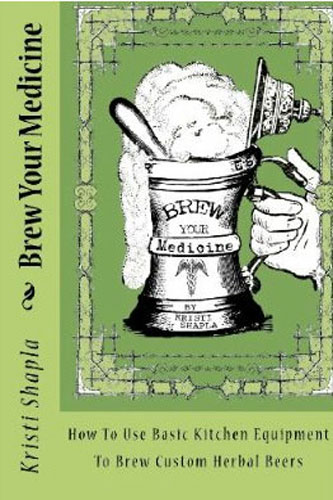Making alcohol from plants is the origin of pharmacy. As such, it became closely associated with ancient doctor-shamans who made herbal medicines preserved in their own self-generated alcohol. In fact, the character yi, meaning “doctor,” is often written in a simplified (variant character) form with the addition of the character for “wine.” This not only refers to the potency of the herbs used in making the alcoholic brew, but also the effect of the alcohol itself in creating an altered mental state.
Since ancient times, one of the major cultural achievements of humankind has been the making of alcohol from plants and malted grains. Historically, a wide variety of herbs were used both for their bitter flavor that offset the nasty taste of brews made only with malted barley or other grains, as well as for the intrinsic medicinal effect of the herbs themselves. The use of hops as a flavoring agent for beer began in Germany and only dates back about a 1,000 years spreading throughout beer-brewing regions of Europe over the following 700-800 years.
A little known fact about the use of hops (Humulus lupulus) in beer is that they are picked from the female flower of the vine and they contain a substantial amount of estrogenic compounds that have a sedative effect on both the mind and male libido. Considering the custom of rolling out the barrel for a barrel of fun – sometimes in the form of wild fraternity or sorority shindigs or macho motor cycle club parties, it is truly ironic that what everyone is choosing to get blotto with is an herbal brew that dampens sensuality and induces sleep. Now doesn’t that put a different slant on the significance of having a ‘beer belly?’
But here’s some good news for all you home-brew fanatics looking for an alternative to hops in beer making: a wonderful, concise new book entitled Brew Your Medicine by herbalist and East West student Kristi Shapla is now available. It tells you exactly how to make oftentimes surprisingly delicious non-hop beers from a wide variety of herbs including a variety of commonly available medicinal herbs as well as complex Chinese formulas to relieve depression, increase energy and vitality, including brews that can actually stimulate libido rather than sedate it – if that is what you are looking for. As to the exquisite flavor and consistency of the brews, I and many others who have sampled Kristi’s herbal beer creations, can enthusiastically attest.
The book is only 70 pages in length and yet offers up a short history of beer, good reasons why you might want to try using herbal combinations other than hops, and short chapters outlining everything you need, including the easily obtained equipment, yeast, barley malt extract, and even a recipe for gluten-free beer. With a degree in microbiology, Kristi dedicates an entire chapter entitled “Keeping it Clean” to prevent foreign yeast and microbes insinuating themselves and ruining all of your efforts at making the superior beer.
Really very little is needed to begin brewing herbs such as hawthorn, ginseng, dang gui, burdock, dandelion, cinnamon, ashwagandha and licorice into a tasty, mildly alcoholic beverage. For those who don’t know or have any interest in obtaining a hydrometer used to determine when fermentation is complete, Kristi describes how to use a balloon with a pinhole affixed to the opening of a gallon jug of fermented brew. While it is still fermenting the balloon remains inflated; as soon as fermentation is finished it goes flat and that is when it is time to bottle and cap your finished herbal brew.
Home herbal medicine-makers, this is a bit of a switch: Instead of putting herbs in alcohol (as when making an herbal tincture), you allow the herbs to extract and preserve themselves with the lowest possible ratio of alcohol. This is how ancient doctors mentioned above preserved and made medicine, and it is also how Chinese shamans called Wu Li masters made herbal brews from yarrow, the same herb they used for divination.
Brew Your Medicine by Kristi Shapla is available online from Amazon and Barnes and Noble.

